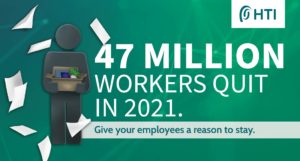Know the truth – the critical first step to combatting turnover, according to HTI’s Chairman & CEO, Herb Dew. Dew sits down with SC BIZ NEWS’ Publisher, Rick Jenkins to dig deeper. “Don’t be afraid to find out the truth,” says Dew. “Take the first step. Understand the truth about where you are with your employees. Then, you can start to move the needle and change your company for the better.”
Workers are quitting their jobs in staggering numbers. In South Carolina alone, an average of 70,000 workers quit each month in 2021 – that’s 3% of the state’s workforce in any given month.
“How are employers dealing with the turnover, and what’s making all these folks quit?,” asks Jenkins. These times are tough for everybody. The disruption has been catastrophic for some. The proof is in the numbers – 47 million people quit their jobs in 2021. 4.2 million families went from two incomes to one. Millions retired early. Couple these record-breaking quits with the fact that there are roughly 60 unemployed people for every 100 job openings, according to a recent Wall Street Journal article. People can go out and get any job they want. Simply, they don’t have to keep doing what they were doing before. Everything has changed and it’s not changing back.

We have to be creative to get people back.
Often, a companies’ first reaction is to pay more. But pay isn’t the only answer. Employees want more. They want unexpected. They want intentional. Dew goes on to explain, “…a quarterly bonus, for example – when an employee receives a bonus, regularly, that becomes expected...” Communication and connectedness are far less expensive than compensation. He continues with an example from his daughter’s employer – socks in a box – a thoughtful, inexpensive, snail-mail sent to every employee with a note from the CEO. “People are still talking about the socks,” says Dew. It was unexpected. It was intentional. “As employers, we have to be unexpected. People want to be connected. We have to think differently to compete for that 1.8%,” he says. We have to know the truth to combat turnover.
An employee won’t leave their current job for more money if they love where they work.
Employers are also facing employees’ desire for flexible scheduling. Ultimately, employees want a choice. “Hybrid will land,” says HTI’s Herb Dew. People need human interaction and collaboration – Zoom and Teams don’t provide the same feeling as in-person. Good companies will give you flexibility. Employees will understand what success looks like in their job which enables an employee to work from anywhere. A lot of companies, however, don’t do well defining what success looks like within a role. The companies that don’t have clear definitions for employees to understand what success looks like within their role, are the companies that will fail at remote work.
What else are employees looking for? 91% of employees feel like their leadership has poor communication skills, according to an article by Harvard Business Review. “Start there,” says Dew.
Whether it’s development, relationships, the company mission, community outreach – you can do a lot of things that don’t cost a lot of money to have a connection to people – especially with people that are remote. Be aware of our blindspots. Know the truth to combat turnover.
Change your mindset to combat turnover.
“Employees have all the leverage these days,” says Mr. Jenkins on his key takeaway from a recent 60 Minutes article.
If employers are not adapting, they’re not going to get the people they need. South Carolina’s unemployment rate currently sits at 3.6%. 53% of those unemployed people aren’t even looking for a job. So, we’re competing for an effective 1.8% of the workforce. “The companies that listen and begin to think about how to change how they approach their engagement with their employees – those employers will have the pick of the litter,” says Dew. “The companies that try to stay doing things the old way – they get what’s leftover and that won’t help their company grow,” he continues.
So, what can we do? What can we control? As companies, are we connected with our employees? Are we working on development? Communicating where we’re going as a company? Connected to our community? Do we know our people – are relationships and trust built? “These things don’t cost a lot of money, if any at all,” says Dew.
Retain if you don’t want to have to continually recruit. Covid created disconnection. Get back to “connected”, says Dew. The pandemic simply exacerbated underlying currents that already existed. The next generation is entering the workforce powerfully. They demand different things than any generation before. They have expectations and will push on just about everything. If we’re going to have these people in our workforce to begin to one day lead our companies, we have to adjust. We have to adapt, or we’ll fall behind.
Do you know the truth? HTI can help you take the first step.
There are pros and cons to the recent disruption in the workplace. The positive? Companies are being forced to think differently about what they do with their workplace – creating innovation out of necessity. The negative? Some companies are getting left behind because they don’t know what to do. For the companies that are leading the way, there will still be a continuous need to keep adjusting to a labor shortage and to understand the different mindset of what people want in a job.
At HTI, Workplace Strategies‘ focus is to help build organizations that create intentionality throughout the employee life-cycle. Dew’s ultimate advice, “Start with understanding the truth about where you are right now. Don’t be afraid to know your employees’ perception of your company. Move the needle by understanding where you are.” Simply, communicate and connect in order to attract and retain.
Know the truth to combat turnover. Adapt or fall behind.
Watch the full interview, here.



Comments